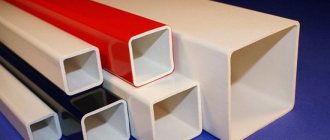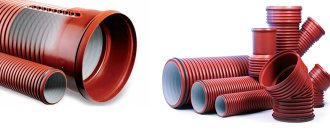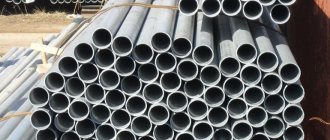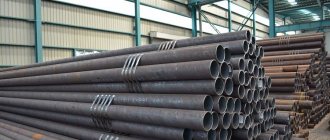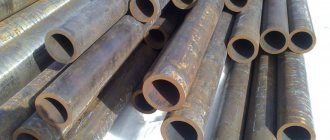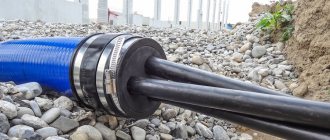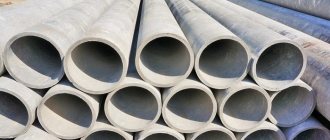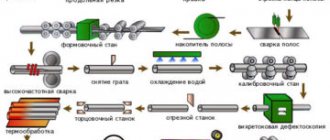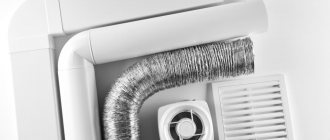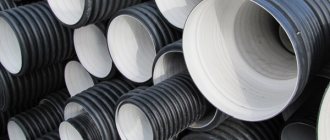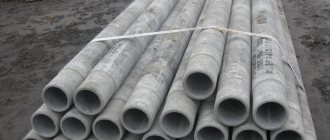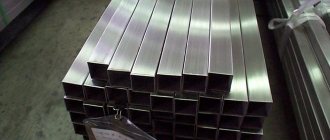HDPE corrugation is a product that is made from low-density polyethylene and is used in various situations. Using a corrugated pipe made of this material, drainage systems are laid, and it also serves to protect cable wiring, acting as a case for cables. Today, there are several types of corrugated HDPE pipes, all of them have high performance characteristics.
Corrugated HDPE pipes have a very wide range of applications
Device
A corrugated HDPE pipe is a hollow channel, the walls of which are made up of evenly alternating sections of varying thickness. The wall can be single-layer, structured on the outside and inside of the product, or two-layer with a smooth inner and ribbed outer surface.
Specifications
This type of corrugated pipes is produced by extrusion from a high-density polymer obtained by the low-pressure polymerization of ethylene (LDPE).
The finished product, depending on the series, has the following technical characteristics:
| No. | Indicator name | Series | |
| Lightweight | Heavy | ||
| 1 | Classification code according to EN 61386-1 and EN 61386-23 | 1342 | 2442 |
| 2 | Degree of protection | IP55 | |
| 3 | Permissible installation temperature range | From -40 ºС to +90 ºС | |
| 4 | Range of permissible operating temperatures | From -40 ºС to +90 ºС | |
| 5 | Strength index | Over 125 N per 5 cm | Over 320 N per 5 cm |
| 6 | Color number according to RAL catalog | 2004 (orange), 7021 (black) | |
| 7 | Minimum bend radius | 3 diameters | |
| 8 | Insulation resistance | Not less than 100 MOM | |
| 9 | Protection class | 0 according to GOST 12.2.007.0 | |
Characteristics, GOSTs and certificates
HDPE pipes have the following technical characteristics:
- can function for at least 50 years;
- do not require further maintenance;
- are not subject to corrosive processes, they are not affected by the presence of fungus, bacteria, or other parasites;
- resistant to chemicals;
- characterized by low material density, which makes the pipeline elements very light;
- very easy to connect into a single highway;
- have low thermal conductivity;
- operate reliably at temperatures 0⁰С - 40⁰С;
- do not delay the flow of working media, since the inner surface is smooth.
If we take into account their elasticity, impact resistance, and low price, then you will not find better pipes for laying a main line.
The production of HDPE technical pipes is constantly evolving as technologies and equipment are regularly improved.
Today, the assortment is regulated by GOST 18599 2001, which defines the requirements for PE pipe parts for laying utility water mains. The technical documentation contains information on the production of technical HDPE pipes with specific characteristics and properties.
The mains mounted from such risers can move not only liquids, but also gases. The temperature of the transported media should not be higher than 40⁰С at low pressure not exceeding 25 atm.
Manufacturing companies engaged in the production of technical HDPE pipes have certificates of product compliance with existing regulatory documentation.
Application area
The scope of application of corrugated HDPE pipes is quite extensive.
They are used:
- As protective and insulating sheaths of electrical wires, telephone, television and computer cables;
- For installation of internal and external sewerage;
- As drain hoses for plumbing fixtures;
- For the construction of stormwater systems and water reduction;
- As ring and reservoir drainage devices;
- As air ducts and drain pipes in ventilation and air conditioning systems.
Classification and types
Single-layer corrugated pipes are classified into two groups:
- Light.
- Heavy type.
Lightweight single-layer HDPE corrugated pipe (corrugated hose) has a simple design, can change length during installation and bend at any angle, and does not require fixation with additional fasteners.
Two types of flexible hoses are available, differing in purpose:
- With a probe. The product is equipped with steel wire for easy drawing of electrical wires.
- No probe. Used to assemble pipelines transporting various liquids.
Heavy series HDPE corrugated hose is usually larger in terms of geometric cross-sectional parameters, is laid in monolithic structures and goes deep into the ground.
Double-wall corrugations have higher strength, flexibility and throughput, which is due to the smooth inner wall.
This type of pipe can be manufactured:
- Entirely made of low-density polyethylene.
- HDPE is used to produce the inner layer, and high-density polyethylene (LDPE) is used for the outer layer.
- With reinforced metal layer. Products of this design withstand high mechanical loads and impacts well and have an increased coefficient of ring rigidity.
Range
Based on their purpose, HDPE pipes are divided into several groups. To make it easier to distinguish them, each type is painted in a specific color:
- tap water: intended for supplying drinking water, painted blue; black products with longitudinal blue veins can withstand even freezing without loss of integrity and do not fade under the sun;
- casing for wells: high-strength blue or black;
- gas: yellow or black with yellow stripes;
- irrigation: pure black;
- sewer: their color depends on operating conditions; gray and white are intended for indoor use; orange and brown (harder and more durable) - for laying highways outdoors; black – for sewage;
- drainage: corrugated, flexible and rigid, able to withstand the weight of the soil, painted blue or green;
- technical: color depends on the type of working fluid.
Advice! You should pay attention not only to the color, but also to the markings. After all, according to GOST, coloring does not necessarily indicate the purpose of pipelines. Therefore, unscrupulous manufacturers may well apply blue stripes to products intended only for technical needs.
The color of the products depends on their purpose
Advantages and disadvantages
The popularity of HDPE corrugation in industry and utilities is due to the presence of the following positive qualities:
- Elasticity, thanks to which you can easily change the angle of rotation during installation.
- Wide range of operating temperatures and resistance to temperature changes.
- Moisture resistance and ability to repel dust.
- Absolute corrosion resistance.
- Wear resistance.
- Low electrical conductivity.
- Resistant to chemical aggression.
- Ecological cleanliness.
- Light weight.
- Resistance to various types of mechanical loads.
- High strength.
- The material does not support combustion.
- Long service life without loss of original properties (at least 50 years).
The disadvantages of such products include:
- Inability to use for assembling hot water supply pipelines.
- Low resistance to ultraviolet radiation.
- Higher cost compared to corrugated PVC pipes.
Comparison of corrugated HDPE and PVC
Each of the two types of plastics has its own strengths and weaknesses, which determine their scope of application.
What is the difference between PVC and HDPE
Both HDPE and PVC are resistant to aggressive chemicals, so they can be used for the construction of pipelines transporting oxides, alkalis, acids, and salts.
HDPE is a more durable material and is frost-resistant, but PVC becomes brittle with significant cooling. Therefore, polyethylene products can be used to protect low-current networks in open areas, lay them in the ground, install pressure and non-pressure wastewater disposal systems, drainage and storm sewers. For internal electrical wiring, PVC corrugation should be used.
PVC-type polymers are self-extinguishing materials, while spot fires are possible in HDPE systems.
Product Standards
Requirements for polyethylene are established by GOST 16338-85. Technical conditions for the production of corrugated HDPE pipes:
- For non-pressure sewer systems it is regulated by GOST R 54475-2011.
- For electrical equipment - GOST 32123.1-2013.
Dimensions
Corrugated PVC pipes for electrical work are sold in convenient for transportation coils of 15, 25, 50 and 100 m. The diameter varies from 16 to 63 mm. Products with a diameter of 110-1200 mm with a wall thickness of 0.8 to 5 mm are produced in lengths of 6 and 12 m.
Marking
As a rule, the product description is reflected on the surface with indelible paint at intervals of 1 m. In addition to the color indication, which indicates the technical purpose, information is applied in the form of numbers, letters and logos. Behind them lies the following:
- Manufacturer. The name, trademark and country may be indicated.
- Raw materials . PE – polyethylene. 32, 63, 80, 100 are nearby - this is the stability of the bonds between the molecules in the granules used.
Factory marking of products Source flexapipe.ru
- HDPE pipe size. The nominal diameter and wall thickness are indicated here.
- SDR. This is the result of dividing the outer diameter values by the wall thickness. The indicator characterizes the strength of the material relative to the pressure exerted on the line.
- P.N. The permissible pressure value at a temperature of +20 degrees Celsius.
- S. Strength classification expressed as a stress-to-pressure ratio with constant data.
- Purpose. In addition to the indication, they separately indicate the permissibility of use for technical needs or for drinking water.
Purpose of products on labeling Source nadezhin.ru
Tips for choosing
To ensure that communications last a long time and that the corrugated pipe itself does not crack during installation and operation, you should only buy certified products from well-known manufacturers. Before purchasing, it is recommended to inspect the polyethylene product for uniformity in length and uniformity of wall thickness.
If a corrugated pipe is needed to protect telephone or alarm cables, connections to lighting fixtures, then a product with a diameter of 16 mm is suitable. Channels for electrical wires for connecting sockets and switches must have a diameter of at least 20 mm. Corrugated products with a diameter of 25 mm are used for protective channels at the connection points of distribution boxes, 32 mm - for electrical panels.
For the installation of internal sewerage, corrugated HDPE pipes with diameters from 40 to 110 mm are mainly used; larger sizes are used for assembling pipelines of external systems.
approximate cost
Prices for corrugated HDPE products are quite low. They directly depend on the design features of the pipe wall, manufacturer and cross-sectional dimensions.
The approximate costs of the most popular sizes are shown in the table below.
| No. | Execution option | Outer/inner diameter, mm | Price for 1 m.p., rub. |
| 1 | Double-walled with socket SN 8 | 110/94 | 200 |
| 2 | 160/136 | 360 | |
| 3 | 200/171 | 480 | |
| 4 | 230/200 | 515 | |
| 5 | 250/216 | 630 | |
| 6 | 290/250 | 840 | |
| 7 | 315/271 | 875 | |
| 8 | Protective single wall SN 8 | 50 | 42 |
| 9 | 63 | 60 | |
| 10 | 90 | 70 | |
| 11 | 110 | 80 |
The best domestic and foreign manufacturing companies
Among the large manufacturers of plastic corrugated pipes that produce high-quality products are the following companies:
- DKS.
- Ecoplast.
- IEK.
- Pragma.
- Corsis.
- FD-layer.
Classification of HDPE pipes
PE products are distinguished by properties and purpose. Thus, technical products are acceptable for laying gravity channels. More durable products are suitable for pressure lines with operating pressures up to 5 or 20 atm. There are also options for operation in conditions close to vacuum.
Regarding the purpose, there are several categories:
- HDPE water pipes for cold water supply in solid blue or black with a similar stripe indication.
PE pipes for cold water supply Source pnevmo.ru
- There are hot water products with red lines, but they are not acceptable for heating systems.
- Gas ones are marked with a yellow or orange tint.
- Sewer lines often have a gray indication. As a rule, they are made with sockets for assembling tracks without fittings. Suitable for internal, external and manifold installations.
Corrugated pipes are used in drainage channels. Reinforced ones are suitable for constructing wells in areas where ground movements are possible. Products are also in demand for assembling irrigation systems. Technical products made from HDPE are relevant for use as insulation for electrical lines.
The table provides information on the applicability of HDPE pipes depending on the raw materials used.
| Area of use/grade (PE) | 32 | 63 | 80 | 100 |
| Relation to internal pressure | Gravity | Pressure | ||
| Gas transportation through external channels | + | |||
| Work with food, industrial liquids and gases | + | + | ||
| Hot and cold water supply inside and outside | + | + | ||
| Providing water for swimming pools | + | + | ||
| Gravity sewer | + | + | + | + |
| Line, drainage system | + | + | + | + |
| Automatic irrigation system | + | + | + | + |
| Protection of electrical networks | + | + | + | + |
Features of installation and dismantling
The process of installing a sewer pipeline from corrugated HDPE pipes includes the following steps:
- Carrying out trench preparation activities.
- Laying pipe sections and joining them.
- Backfilling the trench.
The ditch for gravity sewerage must be 40 cm wider than the laid pipe and must have a slope. The bottom of the trench must be compacted and covered with a layer of sand or medium-sized crushed stone 15-20 cm thick.
Several large-diameter pipes can be connected in sections on the surface and lowered into a prepared ditch using lifting mechanisms. When installing communications for individual houses, pipe sections are placed in a trench manually, where they are sequentially connected into a single structure.
The finished pipeline is first filled with 10-15 cm of sand, and then with soil removed when the ditch was excavated.
Methods for connecting corrugated pipes
The following methods are used to connect HDPE corrugations:
- Bell-shaped Pipes that have a funnel-shaped extension (socket) at one end are laid in the trench so that the socket is turned in the opposite direction from the slope. Next, the bell and the flat part of the next section are cleaned of dust, oil stains and dirt. The sealing ring is put on the second turn of the corrugation and inserted into the socket until it stops.
- Butt welding. For welding corrugated products, the same equipment is used as for connecting smooth HDPE pipes. With its help, the sections of both parts are simultaneously heated, resulting in mutual penetration of molecules and the formation of a monolithic joint that is not inferior in strength to the pipe itself.
- Using fittings. Electric-welded or heat-shrinkable couplings are used to connect large-diameter pipe sections.
Maintenance Tips
The absolute corrosion resistance of corrugated HDPE pipes, resistance to mechanical loads and sub-zero temperatures can significantly increase the interval for maintenance and repair work of sewer systems assembled from them. However, preventing the formation of blockages must be carried out regularly.
There are two ways to clean pipes:
- Chemicals.
- Steam or hot water under high pressure.
